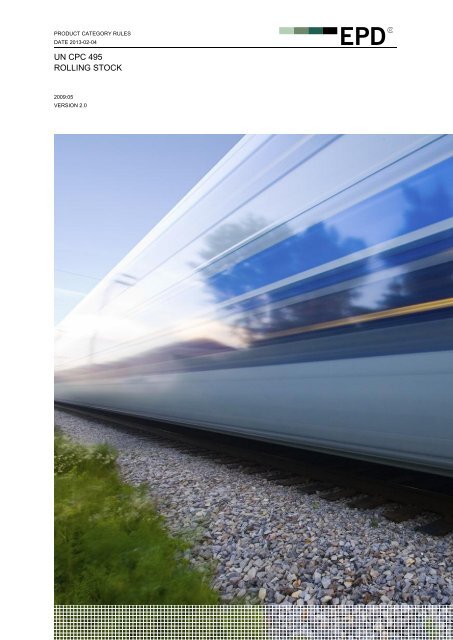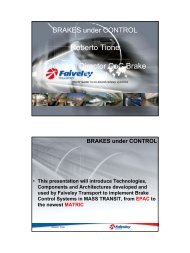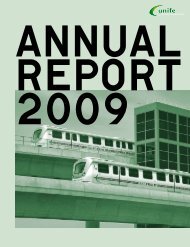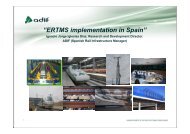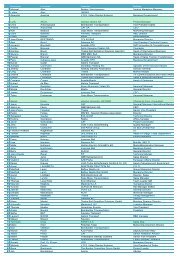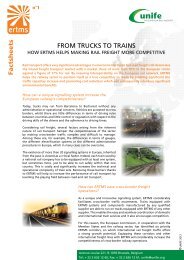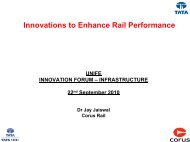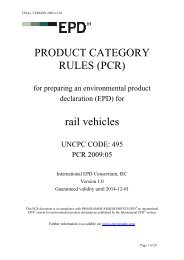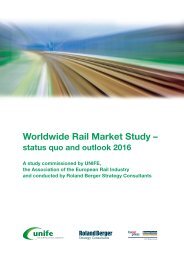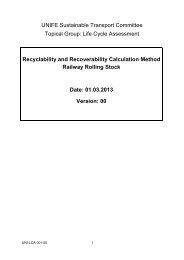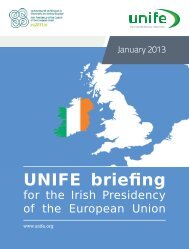Product Category Rules Document - Unife
Product Category Rules Document - Unife
Product Category Rules Document - Unife
Create successful ePaper yourself
Turn your PDF publications into a flip-book with our unique Google optimized e-Paper software.
Cover image: © Istockphoto.comPRODUCT CATEGORY RULESDATE 2013-02-04UN CPC 495ROLLING STOCKGENERAL INTRODUCTIONThe International EPD ® System is based on a hierarchic approach following the international standards:• ISO 9001, Quality management systems• ISO 14001, Environmental management systems• ISO 14040, LCA - Principles and procedures• ISO 14044, LCA - Requirements and guidelines• ISO 14025, Type III environmental declarations• ISO 21930, Environmental declaration of building productsThe General programme Instructions are based on these standards, as well as instructions for developing <strong>Product</strong><strong>Category</strong> <strong>Rules</strong> (PCR).The documentation to The International EPD ® System includes three separate parts (www.environdec.com ):• Introduction, intended uses and key programme elements• General Programme Instructions Supporting annexes• Supporting annexesThis PCR document specifies further and adds additional minimum requirements on EPDs of the product groupdefined below complementary to the above mentioned general requirement documents. Principle programmeelements concerning the <strong>Product</strong> <strong>Category</strong> <strong>Rules</strong> (PCR) included in The International EPD ® System are presentedbelow.PURPOSEComplying with principles set in ISO 14025on modularity and comparabilitySimplifying work to develop <strong>Product</strong><strong>Category</strong> <strong>Rules</strong> (PCR)Secure international participation in PCRworkFacilitating, identification and collection ofLCA-based informationELEMENT IDENTIFICATION AND PRINCIPAL APPROACH1. "Book-keeping LCA approach"2. A Polluter-Pays (PP), allocation method3. PCR Module Initiative (PMI) in order to structure PCR in modulesaccording to international classification4. PCR moderator for leadership and support of the PCR work5. Global PCR Forum for open and transparent EPD stakeholderconsultation6. Selective data quality approach for specific and generic data<strong>Product</strong> <strong>Category</strong> <strong>Rules</strong> (PCR) are specified for specified information modules “gate-to-gate”, so called core modules.The structure and aggregation level of the core modules are defined by the United Nation Statistics Division -Classification Registry CPC codes (http://unstats.un.org). The PCR also provides rules for which methodology anddata to use in the full LCA, i.e. life cycle parts up-streams and down-streams the core module.The PCR also has requirements on the information given in the EPD, e.g. additional environmental information. Ageneral requirement on the information in the EPD is that all information given in the EPD, mandatory and voluntary,shall be verifiable. In the EPD, the environmental performance associated with each of the three life-cycle stagesmentioned above are reported separately.PAGE 2/25
PRODUCT CATEGORY RULESDATE 2013-02-04UN CPC 495ROLLING STOCKTABLE OF CONTENTGeneral Introduction .........................................................................................................................................................21 General information ..................................................................................................................................................51.1 References ..........................................................................................................................................................61.2 Background .........................................................................................................................................................62 <strong>Product</strong> <strong>Category</strong> rules .............................................................................................................................................72.1 Purpose ...............................................................................................................................................................72.2 Publication ...........................................................................................................................................................72.3 Validity .................................................................................................................................................................72.4 Abbreviations .......................................................................................................................................................82.5 Terms and Definitions..........................................................................................................................................83 Definition of the product category ........................................................................................................................... 103.1 Rolling Stock ..................................................................................................................................................... 103.2 <strong>Product</strong> groups .................................................................................................................................................. 114 Function and functional unit .................................................................................................................................... 124.1 Passenger rolling stock ..................................................................................................................................... 124.2 Freight rolling stock ........................................................................................................................................... 125 Materials and Substances ...................................................................................................................................... 136 Units ....................................................................................................................................................................... 137 General system boundaries .................................................................................................................................... 138 Upstream module ................................................................................................................................................... 148.1 System boundaries ............................................................................................................................................ 148.2 Allocation rules .................................................................................................................................................. 158.3 Data quality rules ............................................................................................................................................... 158.4 <strong>Rules</strong> for generic data ....................................................................................................................................... 169 Core module ........................................................................................................................................................... 169.1 System boundaries ............................................................................................................................................ 169.2 Cut-off rules ....................................................................................................................................................... 179.3 Allocation rules .................................................................................................................................................. 179.4 Data quality rules ............................................................................................................................................... 1710 Downstream module .............................................................................................................................................. 1810.1 System boundaries ................................................................................................................................... 1810.210.3Cut-off rules .............................................................................................................................................. 19Allocation rules ......................................................................................................................................... 1910.4 Data quality rules ...................................................................................................................................... 1910.510.6<strong>Rules</strong> for generic data ............................................................................................................................... 19Use phase scenario .................................................................................................................................. 1910.7 End of Life Scenarios ................................................................................................................................ 2011 Environmental Performance Related Information .................................................................................................. 2011.1 Use of resources ....................................................................................................................................... 2011.2 Waste generation ...................................................................................................................................... 2111.3 Environmental impact ............................................................................................................................... 2112 Technical Performance related information ........................................................................................................... 2112.1 Rail vehicle energy consumption .............................................................................................................. 2112.2 Noise emissions ........................................................................................................................................ 22PAGE 3/25
PRODUCT CATEGORY RULESDATE 2013-02-04UN CPC 495ROLLING STOCK12.3 Recyclability and Recoverability ............................................................................................................... 2212.4 PM 10 and NO x emission values for diesel rolling stock ............................................................................. 2213 Other environmental information ............................................................................................................................ 2214 Environmental product declaration content requirements ...................................................................................... 2214.1 Programme related information ................................................................................................................ 2214.2 <strong>Product</strong> related information ....................................................................................................................... 2314.314.4Environmental performance related information ....................................................................................... 23Technical Performance related information .............................................................................................. 2314.5 Other environmental information ............................................................................................................... 2314.6 Differences versus previous versions of the EPD ® ................................................................................... 2314.7 References ............................................................................................................................................... 2314.8 Mandatory statements .............................................................................................................................. 2415 Validity of the EPD ® ............................................................................................................................................... 2416 Changes in this document ..................................................................................................................................... 24PAGE 4/25
PRODUCT CATEGORY RULESDATE 2013-02-04UN CPC 495ROLLING STOCK1 GENERAL INFORMATIONDate: 2013-02-04Registration no: PCR 2009:05 (version 2.0)This PCR was prepared by:Appointed PCR moderator:Valid within the following geographicalrepresentativeness:UNIFE, Sustainable Transport Committee (STC), www.unife.orgKathy Reimann, Bombardier Transportation GmbH,kathy.reimann@de.transport.bombardier.comGlobalValid until: 2018-02-04More information on this PCR’s website:http://www.environdec.com/en/<strong>Product</strong>-<strong>Category</strong>-<strong>Rules</strong>/Detail/?Pcr=5846The development of this <strong>Product</strong> <strong>Category</strong> <strong>Rules</strong> (PCR) document was initiated by UNIFE in June 2008 and thepreparation of the document has been lead by the Sustainable Transport Committee (STC) at UNIFE. Representativesof the different parts of the rail transport sector, system integrators, rolling stock manufacturers, sub-system suppliersand operators have been involved in the development process. The main companies involved have been; AlstomTransport, AnsaldoBreda, Bombardier Transportation, Siemens, Knorr-Bremse and Saft Batteries.The work to develop this PCR was prepared and discussed at several meetings as well as telephone conferences. Thework was started in June 2008 and finalized in October 2009 and subsequently revised according to decisions made.An update of the PCR was conducted during 2011 and 2012; the work was conducted in the same manner as when itwas prepared. In addition to the UNIFE parties involved in the preparation of the first release, CAF and Talgoparticipated in the update.This document describes the <strong>Product</strong> <strong>Category</strong> <strong>Rules</strong> for the assessment of the environmental performance of theproduct category rolling stock, defined in Chapter 3.1. It outlines the criteria for identification of the product categoryand further sets out the parameters to prepare an Environmental <strong>Product</strong> Declaration (EPD ® ) according to ISO 14025.The PCR describes how to perform the underlying Life Cycle Assessment (LCA) according to ISO 14040 and otherenvironmental assessments for the development of an EPD ® according to ISO 14025. The PCR aims to identify andspecify the minimum rules and procedures for:• The functional and performance characteristics of the product category;• The system boundaries, cut-off criteria and allocation rules to be used in the LCA study of products belonging tothe product category;• The information that shall be reported in the EPD ® .This PCR has been developed within the EPD ® system, held by the International EPD ® Consortium (IEC) and alsofollowing the General Programme Instructions for environmental product declarations, EPD ® , version 1.0 dated 2008-02-29.More information on the EPD ® system can be found on www.environdec.com.PAGE 5/25
PRODUCT CATEGORY RULESDATE 2013-02-04UN CPC 495ROLLING STOCK1.1 REFERENCESTable 1 List of references.REFERENCE TITLE REV1907/2006/EC Regulation (EC) No. 1907/2006,concerning the Registration,Evaluation, Authorization andRestriction of Chemicals (REACH)20062008/98/EC Directive 2008/98/EC on waste 2008ISO 14040ISO 14025Environmental management – Lifecycle assessment – Principles andframeworkEnvironmental labels and declarations– Type III environmental declarations– Principles and procedures20062006ISO 14044Environmental management – Life 2006cycle assessment – Requirements andguidelinesISO 22628EN 15380- 2EN 15663GPI 2008KTH 2006TS 50591_2013UNI-LCA-001.00Road vehicles-Recyclability andrecoverability –Calculation methodRailway applications-Designationsystem for railway vehicles- Part 2<strong>Product</strong> GroupsRailway Applications – Definition ofVehicle Reference MassesGeneral Programme Instructions forenvironmental product declarations,EPD, version 1.0 dated 2008-02-29Andersson, E. & Lukaszewicz, P.:Energy consumption and related airpollution for Scandinavian electricpassenger trains, KTHSpecification and verification of energyconsumption for railway rolling stockRolling stock – Recyclability andRecoverability – Calculation method20022:2006200920082006201320131.2 BACKGROUNDAn Environmental <strong>Product</strong> Declaration (EPD ® ) is a certified environmental declaration developed in accordance withthe standard ISO 14025. It presents quantified environmental data for products or systems based on information froma Life Cycle Assessment (LCA) conducted according to the ISO 14040 series of standards, but not excluding additionalenvironmental information. The EPD ® includes information about the environmental impacts associated with a productPAGE 6/25
PRODUCT CATEGORY RULESDATE 2013-02-04UN CPC 495ROLLING STOCKor service, such as raw material acquisition, energy consumption, content of materials and chemical substances,emissions to air, soil and water and waste generation. It also includes product and company information.EPD ® is voluntarily developed information and the purpose is to provide quality-assured and comparable informationregarding environmental performance of products.EPD ® s can reflect the continuous environmental improvement of products over time and are able to communicate andadd up relevant environmental information along a product’s value chain. EPD ® s also add new market dimensions toinform about environmental performance of products and services – objectivity, comparability and credibility.Certified EPD ® s are open for all products and services. There is no evaluation of the environmental information sinceno predetermined environmental performance levels are set. Instead it builds on well-structured and quantitative datacertified by an independent third party.An EPD ® is based on a LCA carried out in accordance with the ISO 14040 series. However, for the results of differentLCA studies to be comparable, they must have the same scope, calculation rules and format for presentation. This isensured in the EPD ® programmes, which prescribes general and product category specific rules for data collection,handling and calculation. <strong>Product</strong> categories can inherently differ in their environmental performance. This must bereflected in the choice of appropriate indicators and calculation rules. For this goal, <strong>Product</strong> <strong>Category</strong> <strong>Rules</strong> (PCR),that are complementary to the general EPD ® programme requirements, is prepared.According to ISO 14025, PCR are a set of specific rules, requirements, and guidelines for developing Type IIIenvironmental declarations for one or more product categories.Trade of products and services often extends national borders which call for a need to harmonise the PCR documentsbeing prepared in various countries by different companies and branch organisations as well as independent bodiesoperating or implementing EPD ® programmes.The PCR process is carried out in an open process in which various stakeholders have the opportunity to comment.This is important to make the PCR documents of as high quality as possible. When all relevant comments areincorporated into the PCR it is approved and established by a technical committee.2 PRODUCT CATEGORY RULES2.1 PURPOSEThe purpose of developing this PCR is to provide the necessary rules and criteria to develop an EPD ® according toISO 14025 for rolling stock included in the product category as defined in Chapter 3.1.EPD ® s for rolling stock following this PCR shall be based on information modules for different technical components ofthe rail vehicle, covering its entire life cycle. The EPD ® s are intended to be printed and distributed primarily forbusiness to business communication.2.2 PUBLICATIONThe PCR document will be published on the International EPD ® system website (www.environdec.com) and isaccessible through the UNIFE website (www.unife.org).2.3 VALIDITYThe validity date is specified in chapter 1. If relevant changes in the LCA methodology or in the product category rollingstock technology occur, the document will be revised and any changes will be published on the InternationalEPD ® system website (www.environdec.com).The EPD shall refer to a specific PCR version number. The production of new PCR versions does not affect the EPDcertification period.PAGE 7/25
PRODUCT CATEGORY RULESDATE 2013-02-04UN CPC 495ROLLING STOCK2.4 ABBREVIATIONSThe following table describes the abbreviations used in this PCR document.Table 2 List of used abbreviations.ABBREVIATIONEPD ®GPIIECMONMMPGPCRSPGSVHCSTCUNCPCLCALCIUNIFEUICWPEXPLANATIONEnvironmental <strong>Product</strong> DeclarationGeneral Programme Instructions for environmental product declarationsInternational EPD® ConsortiumModified organic natural materialsMain product group<strong>Product</strong> <strong>Category</strong> <strong>Rules</strong>Sub product groupSubstances of Very High ConcernSustainable Transport Committee at UNIFEUnited Nations Central <strong>Product</strong> ClassificationLife Cycle AssessmentLife Cycle InventoryUnion des Industries Ferroviaires Européennes – The Association of the European RailIndustryUnion Internationale des Chemins de Fer – International Union of RailwaysWork package2.5 TERMS AND DEFINITIONSThe following table describes the terms and definitions used in this PCR document.Table 3 Terms and definitions.TERMAllocationCo-productCut-off criteriaDEFINITIONPartitioning the input or output flows of a process or a product system between theproduct system under study and one or more other product systems. [ISO 14040]Any of two or more products coming from the same unit process or product system. [ISO14040]Specification of the amount of material or energy flow or the level of environmentalsignificance associated with unit processes or product systems to be excluded from astudy. [ISO 14040]PAGE 8/25
PRODUCT CATEGORY RULESDATE 2013-02-04UN CPC 495ROLLING STOCKTERMData qualityEnergy consumptionEnergy regenerationEPD® SystemDEFINITIONCharacteristics of data that relate to their ability to satisfy stated requirements. [ISO14040]In the context of this PCR, energy consumption means e.g. energy utilization or energyusage. Energy can not be “consumed”, only utilized or converted between different kindsof energy, e.g. chemical energy (in fuels), kinetic energy, potential energy, heat, electricenergy etc. The term ‘energy consumption’ is used because it is common terminology inthe railway sector.Electric energy is fed back to the catenary, while the train is braking or running downhill.Thus some part of the energy intake is recovered.The international EPD® System is a communication tool for international markets. Seemore details at www.environdec.com.Functional unit Quantified performance of a product system for use as a reference unit. [ISO 14040]Generic dataImpact categoryAlso referred to as secondary data – data from commonly available data sources (e.g.commercial databases and free databases), which are allowed to be used to substitutespecific data providing if they fulfill prescribed characteristics. [GPI]Class representing environmental issues of concern to which life cycle inventory analysisresults may be assigned. [ISO 14040]Life Cycle Assessment Compilation of life cycle inventories involving the gathering and quantification of inputsand outputs for a product system throughout its entire life cycle. [ISO 14040]Load factorNet energyThe ratio between the number of passenger-km and the offered number of seat-km.Load factor is sometimes called seat occupancy rate. [KTH 2006]Amount of energy remaining after feeding back energy to network through regenerativebraking, energy recovery.Process Set of interrelated or interacting activities that transform inputs into outputs. [ISO 14040]<strong>Product</strong>Any goods or service. The product can be categorized as follows:- services (e.g. transport)- software (e.g. computer program, dictionary)- hardware (e.g. engine mechanical part)- processed materials (e.g. lubricants) [ISO 14040]System boundary Set of criteria specifying which unit processes are part of a product system. [ISO 14040]Specific dataUnit processWasteAlso referred to as primary data – data gathered from the actual manufacturing plantwhere product specific processes are carried out. [GPI]Smallest element considered in the life cycle inventory analysis for which input andoutput data are quantified. [ISO 14040]Substances or objects which the holder intends or is required to dispose of. [2008/98/EC]PAGE 9/25
PRODUCT CATEGORY RULESDATE 2013-02-04UN CPC 495ROLLING STOCK3 DEFINITION OF THE PRODUCT CATEGORYThis PCR is applicable for the product category rolling stock and refers to all types of rolling stock, e.g. locomotives,passenger carriages, goods wagons, etc. The system boundaries as well as inputs and outputs for the productcategory can be seen as an overview in Figure 1 .Non renewable energy resources<strong>Product</strong>ion of MaterialsRenewable energy resources<strong>Product</strong>ion of VehiclesTrain Operation & MaintenanceRecycling of VehiclesMaterial resourcesRail VehiclesWasteEmissionsFigure 1. Overview of the product category rolling stock3.1 ROLLING STOCKThis PCR is applicable for all rolling stock. Based on the service they provide two major types of rolling stock can bedistinguished: Passenger (A) and Freight (B), see Table 4.Table 4 Rolling stock service types.CHARACTERISTICSA. Passenger service typesUrban- Inner city- Very short distance between stations- High passenger capacitySuburban - Mainline service- Short distance between stations- High train frequency- High passenger capacity- Short term on-board timeUTILIZED VEHICLES- Totally low or partially low floor tramways- Light rail vehicles- Heavy rail vehicles- Metros- People Movers- Heavy rail vehicles- Single- and double-deck electric multiple units- Hybrid vehicles such as tram-trainsPAGE 10/25
PRODUCT CATEGORY RULESDATE 2013-02-04UN CPC 495ROLLING STOCKCHARACTERISTICSA. Passenger service typesRegional - Mainline service- Medium to long distance between stations- Average train frequency- Average number of passengersIntercity - Mainline service- Medium to long distance between stations- Direct city-to-city connectionsHigh / Very - Mainline servicehigh speed - Medium to long distance between stations- Direct main city connectionsB. Freight service typesMainline - Mainline service- Long distance between stopsUTILIZED VEHICLES- Single- and double-deck electric multiple units- Electric/diesel locomotives with single- and double-deckpassenger coaches- Diesel multiple units for non electrified lines- Coaches- Single- and double-deck electric multiple units- Electric/diesel locomotives with single- and double-deckpassenger coaches- High performance diesel multiple units for non electrifiedlines- Coaches- Single- and double-deck electric multiple units,specialized for high speed service- Electric/diesel locomotives and goods wagons indifferent typologies depending on the cargo3.2 PRODUCT GROUPSFor the rolling stock covered by this PCR, five main product groups have been distinguished.These five product groups can be used for all possible variants of rolling stock applications and include various mainproduct groups (MPG) as well as sub product groups (SPG) as defined in the EN 15380-2 standard. The designationsystem of the product group structure can be seen in Table 5.Table 5 Detailed description of the included product groups (EN 15380-2).PRODUCT GROUP MPG SPG1. Carbody B body (A), underframe (B), side walls (C), roof (D), head of vehicle (E), end walls (F), weldon/add-onparts (G), intermediate floor (H), partitions (J)S vehicle linkage devices (A), automatic coupling devices (B), manual coupling devices (C),buffing gear (D), Towing gear: emergency couplings (E), gangway (F), vehicle-vehicleinterface for media + signal + power (G)2. Interior, windowsand doorsC vehicle fitting out (A), windows (B), floor (C), interior panelling (D), partitions (E), externaladditions (F), vehicle paintwork (G), insulation (H)D interior appointments (A), inside rails and handles (B), seats + sleeping berths + tables(C), sanitary facilities (D), luggage racks (E), additional devices (F)N doors and entrances (A), external doors (B), internal doors (C), not inside entrances +steps (D), entrances for the disabled (E)3. Bogies andrunning gearsE running gear (A), supporting structures (B), wheel sets (C), suspension + damping +balancing gear (D), active driving system (E), passive driven system (F), safety add-ons(G)R brake (A), brake components (B), mechanical brake force transmission (C)Q pneumatic and hydraulic equipments (A), generation (B), treatment (C), storage (D),distribution (E)M ancillary operating equipment (A), sanding equipment (B) lubricating equipment (C), pointsoperating equipment (D), ticket machines (E), passenger counting device (F)4. Propulsion andelectric equipmentF power system and drive unit (A), power supply (B), power generation (C), powerconversion (D), power dissipation (E), power storage (F)PAGE 11/25
PRODUCT CATEGORY RULESDATE 2013-02-04UN CPC 495ROLLING STOCKPRODUCT GROUP MPG SPGG control apparatus for train operations (A), power supply controls (B), driving and brakecontrols (C), power generation controls (D), system data acquisition (E), power storagecontrols (F)H ancillary operating equipment (A), converter equipment (B), battery device (C), on-boardsupply system (D), cooling unit for power and drive systems (E), emergency powergenerators (F)J monitoring and safety device (A), measuring and protective devices (B), indicating +recording + display devices (C), safety equipment (D), data transmission devices (E),communication equipment (F), miscellaneous equipment (G)K lighting (A), exterior lighting equipment (B), interior lighting equipment (C)P information facilities (A), visual information facilities (B), visual information elements (C),entertainment (D), advertising (E), audible information facilities (F)T carrier system + enclosures (A), cabinets + boxes + containers (B), frames + boards (C),control and display units (D), electronic rack systems (E)U electrical wiring –A), cables + conductors + bars (B), marking and connection materials(C), connecting material (D), bushings (E), cable ducts + pipes + flexible tubes (F)5. Comfort systems L air conditioning (A), intake/evacuation of air (B), treatment (C), distribution (D), regulation(E)4 FUNCTION AND FUNCTIONAL UNITThe functional units for the different types of rolling stock as described in Chapter 3.1 shall be used to normalize theconsidered inputs, outputs and environmental impacts of the studied product system.4.1 PASSENGER ROLLING STOCKThe main function of a passenger rolling stock is the transportation of a given number of passengers over a predefineddistance. The functional unit chosen to quantify the main function is transport of 1 passenger for 1 km.The total number of passengers shall be calculated, according to the EN 15663 standard, for the rolling stock in itsconfiguration.4.2 FREIGHT ROLLING STOCKThe main function of a rolling stock for freight transportation is the transportation of a given amount of goods over apredefined distance. The functional unit chosen to quantify the main function is the transport of 1 ton 1 for 1 km.The total weight taken into consideration shall include the weight of the locomotive, all rail-cars, and the weight of thecargo.1 1 ton = 1000 kgPAGE 12/25
PRODUCT CATEGORY RULESDATE 2013-02-04UN CPC 495ROLLING STOCK5 MATERIALS AND SUBSTANCESThe used materials of the rolling stock shall be classified into the following seven categories, according to ISO 22628• Metals;• Polymers, filled and unfilled (excluding elastomers: rubber);• Elastomers;• Glass;• Fluids;• Modified organic natural materials (MONM), such as leather, wood, cardboard and cotton fleece;• Electric and electronic equipment• Others, including components and/or materials for which the material contents cannot be established).A detailed material report shall be part of the LCA report.The major railway industry companies agreed on a common management methodology including a list of substancesthat are to be controlled, the Railway Industry Substance List, available at http://www.unifedatabase.org/download.php.The list provides a comprehensive and accurate list of the prohibited and declarablechemicals used specifically by the railway industry.6 UNITSSI units shall be used for both the LCA study and the EPD ® . Electricity consumption figures can be given in kWh(MWh, GWh) knowing that 1kWh = 3.6 MJ.7 GENERAL SYSTEM BOUNDARIESThe life cycle of the rolling stock consists of three major modules: upstream, core and downstream, an overview ofwhich is shown in Figure 2 Rolling Stock System Boundaries. The environmental performance of the rolling stock shallbe reported separately for each module. The LCA calculations shall include all upstream, core and downstreamprocesses as described in Chapters 8, 9 and 10 respectively.Upstream, core and downstream processes within the system boundaries are the ones related only with theproduction, operation and disposal of the rolling stock. Those processes are shown in the coloured circle Figure 2Rolling Stock System Boundaries. Facilities and infrastructure that are not part of the subject of the study itself are outof the system boundaries (i.e. facilities for energy and material production, roads and infrastructure for transport,manufacturing plants, rail infrastructure and dismantling process and disposal facilities). Those processes are in shownin grey in Figure 2. Exclusion of any process within the system boundary, as described in Chapters 8, 9 and 10, shall ingeneral be avoided and if necessary shall be justified and reported in the EPD.PAGE 13/25
PRODUCT CATEGORY RULESDATE 2013-02-04UN CPC 495ROLLING STOCKFigure 2 Rolling Stock System Boundaries8 UPSTREAM MODULE8.1 SYSTEM BOUNDARIES8.1.1 BOUNDARIES IN THE LIFE CYCLEThe following upstream processes shall be included:• Extraction and production of raw and basic materials – e.g. aluminium, stainless steel, polyethylene, etc.- This shall include all the associated processes like mining, transportation, used electricity, heat, steam andfuel. The waste generated from the included processes and its treatment shall also be included. All thisinformation is often incorporated in the LCA tool when a cradle-to-gate process/dataset for materialproduction is selected, e.g. steel.• <strong>Product</strong>ion of auxiliary materials for rail vehicle assembly/manufacturing• Transportation from tier 1 (direct) suppliers to the rolling stock assembly/manufacturing facility, amount in % byweight of the train shall be specified /in the EPD.The following upstream processes shall be excluded:• Building, maintenance, dismantling and disposal of material and energy production plants• Building, maintenance, dismantling and disposal of suppliers’ manufacturing facilities• Transportation of raw and basic materials to suppliers’ manufacturing• <strong>Product</strong>ion of components by suppliers• <strong>Product</strong>ion of packaging• Transportation of auxiliary materials to assembly plantPAGE 14/25
PRODUCT CATEGORY RULESDATE 2013-02-04UN CPC 495ROLLING STOCK8.1.2 BOUNDARY IN TIMELife cycle inventory (LCI) data shall be taken as 12 months averages and shall be representative for the year/timeframe for which the EPD ® is valid.8.1.3 BOUNDARY TOWARDS NATUREAll resources from nature and emissions to nature should be included in the calculations.8.1.4 BOUNDARY TOWARDS GEOGRAPHYLCI data describing the energy and material inputs and outputs shall be representative for the country or the region inwhich the processes are taking place. In rare cases when no other information is available global data, e.g. worldaverage values may be used.8.1.5 CUT-OFF RULESAll available elementary flows shall be included.The total mass of the materials not included in the LCA based on the general cut-off rule must not exceed 5% of thetotal mass of the rolling stock. This criterion does not apply for substances included in the Railway Industry SubstanceList (http://www.unife-database.org/download.php) which shall be included in the LCA as far as possible.If certain data is unavailable a sensitivity check based on a set case scenario shall be applied in order to include allsignificant environmental impacts. The set case scenario to be used is outlined below:• Any missing material production shall be represented by “EU Aluminium manufacturing”• Any missing component production shall be represented by “Part machining”• Any missing transport shall be represented by “500 km of road transport”No action is needed if these processes do not contribute more than 1% to each of the considered impact categories ofthe final result. If, however, they contribute more than 1% additional effort needs to be applied in trying to find moreinformation for a specific process to see if a more accurate figure can be obtained.8.2 ALLOCATION RULESThe allocation for the processes included in the upstream module is most often done by the LCA software system andthe underlying datasets in its database. A description of the methodology used shall be presented in the LCA reportaccording to ISO 14044.8.3 DATA QUALITY RULESSelected generic data representing country or regional averages can be used for electricity, heat, steam, fuel andmaterials production processes if specific data is unavailable. Specific data can be used for the transportation ofdifferent product groups/MPG/SPG to the rail vehicle assembly plant.Specific data from upstream manufacturers applying the International EPD system, other EPD systems or ISO 14025should be accepted. However, care shall be taken for consistency for all data used.PAGE 15/25
PRODUCT CATEGORY RULESDATE 2013-02-04UN CPC 495ROLLING STOCK8.4 RULES FOR GENERIC DATAThe selected generic data used shall not be older than 1990. The following data sources can be used when specificdata is not available:Table 6 Selected generic data sources.MATERIAL/PROCESSSteel, Primary copper, Copper products,Electricity, Fuels, Aluminium, Chemicals,Transports, Waste management,PlasticsElectronic componentsINVENTORY DATABASE- PE-GaBi- ELCD- Ecoinvent- EIME- Plastics Europe (Association of Plastics Manufacturers in Europe)- PE-GaBi- ELCD- Ecoinvent- EIME- PE-GaBi- ELCD- Ecoinvent- EIMEIf these data sources do not supply the necessary data, other generic data sources listed at thehttp://lct.jrc.ec.europa.eu may be used. It is recommended to consistently use one database (see Table 6) for theentire LCA.The calculated environmental impact associated to other generic data (not listed above) shall not exceed 10% for thetotal product system. All data sources used shall be declared within the LCA report.9 CORE MODULE9.1 SYSTEM BOUNDARIES9.1.1 BOUNDARIES IN THE LIFE CYCLEThe following core processes shall be included:• <strong>Product</strong>ion and use of electricity, heat, and steam fuel used for the vehicle assembly.• <strong>Product</strong>ion and use of known auxiliary materials (welding, mounting equipment, etc. which are not included inupstream module) used for the vehicle assembly.• Transportation of the rail vehicle from the assembly facility to the location of its use (to the customer)• Waste generated and treatment of waste from the assembly processes on the Rolling Stock manufacturer siteThe following processes shall be excluded:• Building, maintenance, dismantling and disposal of rail vehicle assembly/manufacturing facilities• Packaging of rail vehiclePAGE 16/25
PRODUCT CATEGORY RULESDATE 2013-02-04UN CPC 495ROLLING STOCK9.1.2 BOUNDARIES IN TIMELCI data shall be taken as 12 months averages and shall be representative for the timeframe for which the EPD ® isvalid.9.1.3 BOUNDARIES TOWARDS NATUREAll material and energy flows into and emissions from the core module shall be considered.9.1.4 BOUNDARY TOWARDS GEOGRAPHYThe LCI data shall be representative for the site/region where the rail vehicle is assembled.9.1.5 BOUNDARIES TOWARDS OTHER PRODUCT LIFE-CYCLESIf there is an inflow of recycled material to the production system in the core module, the recycling process and thetransportation from the recycling process to where the material is used shall be included. If there is an outflow ofmaterial to recycling, the transportation of the material to the recycling process shall be included. The material that isgoing to recycling is then considered an outflow from the production system.9.2 CUT-OFF RULESActivities and materials not included in the LCA shall be documented and justified in the LCA report.If certain data is unavailable a sensitivity check based on a set case scenario shall be applied in order to include allsignificant environmental impacts. The set case scenario to be used is outlined below:• Any missing material production shall be represented by “EU Aluminium manufacturing”• Any missing component production shall be represented by “Part machining”• Any missing transport shall be represented by “500 km of road transport”No action is needed if these processes do not contribute more than 1% to each of the considered impact categories ofthe final result. If, however, they contribute more than 1% additional effort needs to be applied in trying to find moreinformation for a specific process to see if a more accurate figure can be obtained.9.3 ALLOCATION RULESThe allocation of the environmental impact to different co-products from the same process within the core module (e.g.assembly) should be avoided. This can be done by applying a more detailed process description and separating thedifferent production lines. If that is not possible the allocation may be based on mass criteria or man-hours used for theproduction of each co-product. The use of economic criteria for allocation should be avoided because of its highsensitivity to market prices which can change a lot. Any allocation shall be justified and the procedure described in theLCA report.9.4 DATA QUALITY RULESThe material composition, the weight and the total weight of the components/modules necessary to specify thematerial utilization for the rail vehicle production shall be acquired by the suppliers.Site-specific data shall be used for all core processes including on-site generation of steam, heat, and electricity ifrelevant. The electricity mix used in the core processes should be the supplied mix. The energy mix used for electricitygeneration shall be documented in the LCA report. If such information is not available the country average electricitymix or steam/heat production shall be used.Site-specific data shall be used for all auxiliary materials used in the process of rail vehicle assembly.PAGE 17/25
PRODUCT CATEGORY RULESDATE 2013-02-04UN CPC 495ROLLING STOCKTransport of the assembled rail vehicle to the final point of use by the customer shall be based on specific data for theactual transportation mode and distance.10 DOWNSTREAM MODULEThe information for the downstream module shall be presented separately for the use phase and end-of life phase, toget a better transparency of the result.10.1 SYSTEM BOUNDARIES10.1.1 BOUNDARIES IN THE LIFE CYCLEThe following downstream processes shall be included:• <strong>Product</strong>ion and consumption of electricity and/or fuel for rail vehicle operation (well to tank)• <strong>Product</strong>ion of materials used to operate the vehicle, e.g. brake pads and flange lubrication• <strong>Product</strong>ion of maintenance materials and spare parts (based on the rail vehicle preventive maintenance program)• Waste from maintenance materials and spare parts (based on the rail vehicle preventive maintenance program)• Direct disposal of materials or incineration residues• Incineration of materials with no energy recoveryThe following processes shall be excluded:• Building, maintenance, dismantling and disposal of rail vehicle disassembly and waste treatment facilities• Building, maintenance, dismantling and disposal of railway infrastructure and service facilities• •<strong>Product</strong>ion and use of cleaning agents used during rail vehicle operation• Treatment and disposal of waste generated from passenger rail vehicles during operation• Energy recovery from waste incineration• Material recycling• Re-use of rail vehicle components10.1.2 BOUNDARY TOWARDS GEOGRAPHYThe LCI data describing the energy and material inputs and outputs shall be representative for the country or theregion in which the rail vehicle operation is taking place. For example the electricity mix of the country where the railvehicle will be in service shall be assumed.10.1.3 BOUNDARIES IN TIMEThe LCI data shall reflect the current time period of production based on realistic conditions related to the use phaseand end-of-life scenarios.10.1.4 BOUNDARIES TOWARDS NATUREAll resources from nature and emissions to nature shall be included in the calculations.PAGE 18/25
PRODUCT CATEGORY RULESDATE 2013-02-04UN CPC 495ROLLING STOCK10.1.5 BOUNDARIES TOWARDS OTHER PRODUCT LIFE-CYCLESInputs and outputs to and from the rail vehicle operation and maintenance activities from and to other technicalsystems should be described.10.2 CUT-OFF RULESProcesses and activities that contribute to less than 1% of the total environmental impact for any impact category canbe omitted from the inventory analysis for the downstream module.If certain data is unavailable a sensitivity check based on a set case scenario shall be applied in order to include allsignificant environmental impacts. The set case scenario to be used is outlined below:• Any missing material production shall be represented by “EU Aluminium manufacturing”• Any missing component production shall be represented by “Part machining”• Any missing transport shall be represented by “500 km of road transport”No action is needed if these processes do not contribute more than 1% to each of the considered impact categories ofthe final result. If, however, they contribute more than 1% additional effort needs to be applied in trying to find moreinformation for a specific process to see if a more accurate figure can be obtained.10.3 ALLOCATION RULESNo allocation shall be made for materials subject to material recycling or energy recovery and these shall be regardedas outputs from the product system. The general principles to follow for the allocation of environmental burdensbetween product systems are:• The environmental impact associated with the treatment of wastes not being used as a resource in another productsystem lies with the generator• The environmental impact associated with the processing of the waste into resource for subsequent use lies withthe user of that resource10.4 DATA QUALITY RULESThe data used for the rail vehicle operation shall represent the state of the art of the technological level for the railvehicle fleet.Data on the pollutant emissions from the use phase shall be based on documented tests, verified studies inconjunction with average or typical rail vehicle use, or specific design criteria. Whenever applicable, test methods shallbe internationally recognized.The energy mix used for electricity production during the use phase shall be operator specific. If such data isunavailable the region/country average electricity mix shall be assumed. The selected mix shall be documented andpresented in the LCA report and in the EPD ® .The information regarding the end-of-life phase based on specific scenarios (Chapter 10.7), shall be technically andeconomically practicable and compliant with current regulations.10.5 RULES FOR GENERIC DATAThe same rules apply as for the upstream module (see Chapter 8.4).10.6 USE PHASE SCENARIOEnergy consumption can be acquired by simulation data calculation, real time measurements or standard duty cycles.The manner of data acquisition shall be specified in the EPD.PAGE 19/25
PRODUCT CATEGORY RULESDATE 2013-02-04UN CPC 495ROLLING STOCKThe energy consumption of a rail vehicle shall be defined if applicable according to TS 50591_2013.The criterion for the energy consumption of a rolling stock is the total net energy consumed at pantograph over apredefined operational profile, which is either taken from the future operation of the train, or according to astandardized profile valid for the specific category of rolling stock.The criterion for the diesel consumption of a rolling stock is the total amount of diesel consumed over a predefinedoperational profile, which is either taken from the future operation of the train, or according to a standardized profilevalid for the specific category of rolling stock.10.7 END OF LIFE SCENARIOSThe end-of-life modelling shall follow the Rolling stock – Recyclability and Recoverability – Calculation method.11 ENVIRONMENTAL PERFORMANCE RELATED INFORMATIONIn the LCA report and in the EPD ® all data shall be declared separately as total value and per functional unit for the:• Upstream module, according to Chapter 8;• Core module, according to Chapter 9;• Downstream module, separated in to use phase and end of life phase, according to Chapter 10;• Total life cycle.11.1 USE OF RESOURCESThe consumption of the following natural resources and resources per functional unit shall be reported in the EPD ® :• Non-renewable resources- Material [kg]○ Top three contributors○ Others- Energy (used for energy conversion processes) [MJ]○ Top three contributors○ Others• Renewable resources- Material [kg]○ Top three contributors○ Others- Energy (used for energy conversion processes) [MJ]○ Top three contributors○ Others• Water use• Electricity consumption (during manufacturing)• Use of recycled resourcesA detailed report of the resource use shall be provided in the LCA report.PAGE 20/25
PRODUCT CATEGORY RULESDATE 2013-02-04UN CPC 495ROLLING STOCK11.2 WASTE GENERATIONThe amounts of waste generated through the rail vehicle life cycle shall be declared in at least the following category:• TotalThe life cycle impact assessment method used shall be declared in the LCA report.11.3 ENVIRONMENTAL IMPACTThe environmental impact per functional unit for the following environmental impact categories shall be reported in theEPD ® , divided into core, upstream and downstream module (separating the use and end-of-life phases):• Emissions of greenhouse gases (expressed as the sum of global warming potential in CO 2 equivalents)• Emission of ozone-depleting gases (expressed as the sum of ozone depleting potential in CFC 11 equivalents)• Emission of acidifying gases (expressed as the sum of acidifying potential in SO 2 equivalents)• Emission of substances to water contributing to oxygen depletion/eutrophication (expressed as the sum of oxygenconsumption potential in O 2 or PO 4 3- equivalents)• Emissions of gases that contribute to the creation of ground level ozone (expressed as the sum of ozone-creatingpotential in C 2H 4 equivalents)Table 7 Summary of impact categories and units to be declared in the EPD®.IMPACT CATEGORYGlobal Warming Potential (GWP) for the time horizon 100 yearsOzone Depletion Potential (ODP) for the time horizon 20 yearsAcidifying Potential (AP)Eutrophication Potential (EP)Photochemical Ozone Creation Potential (POCP)UNITkg CO 2 equiv.kg CFC 11 equiv.kg SO 2 equiv.; baselinekg PO 3- 4 equiv.; baselineand/or kg O 2kg C 2H 4 equiv.; baselineThe impact characterization method used for converting the data from the life cycle inventory analysis into the impactcategories shall be CML2001 and/or IPCC 2007.If other reference values are considered those shall be documented and their use justified in the LCA study report. Theimpact that this choice has on the final results shall be highlighted in the EPD ® .12 TECHNICAL PERFORMANCE RELATED INFORMATIONThe following information shall be published in the EPD ® . All technical parameters should be in reference to anestablished standard.12.1 RAIL VEHICLE ENERGY CONSUMPTIONThe following indicators shall be declared in the EPD ® :• Electricity consumption – for electric rolling stock• Fuel consumption – for diesel rolling stockAll major assumptions for the model of rail vehicle operation made according to Chapter 10.6 shall be included in theEPD ® . Those shall include, but are not limited to:• Total number of passengers used in the calculationsPAGE 21/25
PRODUCT CATEGORY RULESDATE 2013-02-04UN CPC 495ROLLING STOCK• Load factor [%]12.2 NOISE EMISSIONSThe noise emissions of the rail vehicle shall include, but is not limited to, outside noise measured during rail vehicletype testing:• Stationary sound pressure level• Acceleration sound pressure level• Constant speed sound pressure levelThe standard used to perform the measurements shall be declared in the EPD ® .12.3 RECYCLABILITY AND RECOVERABILITYThe recyclability and recoverability rates of the rail vehicle shall be calculated preferably according to the Rolling stock- Recyclability and Recoverability – Calculation method which provides detailed information on the calculation stepsand the material recycling figures. The standard used to perform the calculation shall be declared in the EPD®.12.4 PM 10 AND NO X EMISSION VALUES FOR DIESEL ROLLING STOCKThe PM 10 and NO x emissions shall be declared for diesel rolling stock in the EPD ® . The values shall be those of theactual measurements during rail vehicle type testing. The standard used for type testing shall also be declared in theEPD ® .13 OTHER ENVIRONMENTAL INFORMATIONAdditional information that is identified as an important environmental aspect of the rail vehicle or information asked bythe customer and other stakeholders can be addressed in the EPD ® .In this section can be included information about the potential environmental benefit (avoided burden) from materialrecycling and energy recovery of certain materials based on Chapter 12.3., if this effect is not already included in theupstream module.The application of the Railway Industry Substance List can be stated in this section.14 ENVIRONMENTAL PRODUCT DECLARATION CONTENTREQUIREMENTS14.1 PROGRAMME RELATED INFORMATIONThe programme related part of the EPD ® shall include:• Name of the programme and programme operator;• The reference PCR document;• Registration number;• Date of publication and validity;PAGE 22/25
PRODUCT CATEGORY RULESDATE 2013-02-04UN CPC 495ROLLING STOCK• Information about the year or reference period of the underlying data to the EPD ® ;• Statement regarding comparability of environmental product declarations from different programs;• Reference to the homepage for more information (www.environdec.com);14.2 PRODUCT RELATED INFORMATIONThe EPD ® shall contain the mandatory information according to ISO 14025 as well as further optional information,specifically:• Identification and short description of the organization developing the EPD ® ;• Short description of the Environmental Management System used by the organization;• Description of the rail vehicle service type according to Chapter 3.1;• Description of the rail vehicle’s modular structure according to Chapter 3.2;• Clear product identification including name, model, variation and main characteristics;• Description of the material contents according to Chapter 5;14.3 ENVIRONMENTAL PERFORMANCE RELATED INFORMATIONThe upstream, core and downstream modules shall be reported per functional unit in the EPD ® separately for:• Use of resources according to Chapter 11.1• Waste generation according to Chapter 11.2• Environmental impact according to Chapter 11.314.4 TECHNICAL PERFORMANCE RELATED INFORMATIONInformation regarding the technical performance of the rail vehicle shall be reported in the EPD ® for:• Rail vehicle energy consumption according to Chapter 12.1• Noise emissions according to Chapter 12.2• Recyclability and Recoverability according to Chapter 12.3• PM 10 and NO x emission values for diesel rolling stock according to Chapter 12.414.5 OTHER ENVIRONMENTAL INFORMATIONAdditional information that is identified as an important environmental aspect of the rail vehicle or information asked bythe customer and other stakeholders can be addressed in the EPD ® (Chapter 13).14.6 DIFFERENCES VERSUS PREVIOUS VERSIONS OF THE EPD ®Where relevant, a short description of the changes in the environmental performance of the rail vehicle in comparisonwith previous issues of the EPD ® shall be provided.14.7 REFERENCESThe EPD ® shall refer to relevant references, e.g.:• The underlying LCA report• The PCRs usedPAGE 23/25
PRODUCT CATEGORY RULESDATE 2013-02-04UN CPC 495ROLLING STOCK• Other documents that verify and complement the EPD ®• Instructions for recycling• General programme instructions14.8 MANDATORY STATEMENTSThe EPD ® shall include a justification for any omission of life cycle stages, if relevant. The EPD ® shall include thefollowing statement:“EPD ® s within the same product category but from different programmes may not be comparable.”The EPD ® shall also include information about the applied verification procedure, inserted in the following box.PCR review, was conducted by:Independent verification of the declarationand data, according to ISO 14025:Technical Committee of the International EPD ® SystemEPD process certificate or EPD verification, name of thethird party verifierAccredited or approved by (if relevant):Name of the organisationA statement for the period of validity of the EPD ® shall be included.15 VALIDITY OF THE EPD ®To be agreed with the verifier.16 CHANGES IN THIS DOCUMENTVERSION 1.0 2009-12-01Original versionVERSION 1.1 2010-04-23Small update.VERSION 2.0 2012-01-23General update of the document.PAGE 24/25
PRODUCT CATEGORY RULESDATE 2013-02-04UN CPC 495ROLLING STOCK© 2013 THE INTERNATIONAL EPD ® SYSTEMPAGE 25/25


